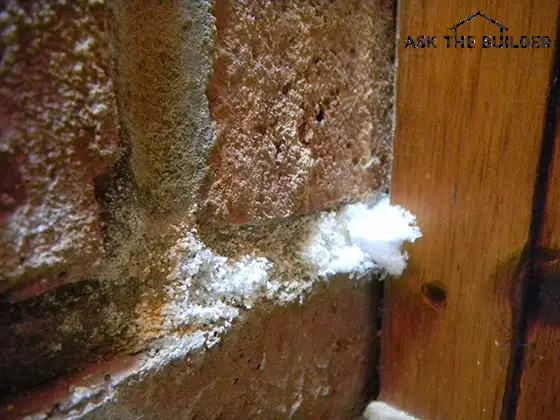Chimney Crown Repairs

Efflorescence growing in the mortar of a brick fireplace. PHOTO CREDIT: Michael Hannum
DEAR TIM: My three year old house has a brick chimney. While performing a routine inspection of my roof, I noticed numerous cracks in the mortar cap on the top of the chimney. Furthermore, the face of some bricks are beginning to flake. Is it possible that water is entering my chimney through the cracks and causing the bricks to flake? Is it normal for this amount of deterioration to occur in such a short amount of time? Was my chimney constructed properly? P. E.
DEAR P. E.: The photos of your chimney tell the tale. You were victimized by a non-professional brick mason. Your chimney crown (mortar cap) has numerous defects. Unless you correct these problems, you can expect further, rapid deterioration of your chimney.
Chimneys are basically very small structures. Just as your house needs a roof to keep water from entering, so to your chimney. Chimney crowns are simply chimney roofs. The crown should slope down from the flue liner. The angle of this slope should be a minimum of 3 inches of fall per foot of run. Flat or low slope crowns can allow water to enter the interior of the chimney. This water can cause efflorescence (white salt deposits on brick surface), brick spalling (the flaking you are experiencing), and the deterioration of the mortar between individual bricks.
All too often, brick masons simply use mortar mix to finish off the top of a chimney. Chimney crowns should be constructed using either pre-cast concrete slabs, cast-in-place steel reinforced concrete, solid stone, or metal. Masonry crown materials should not directly contact the chimney flue liner. This gap should be caulked with a flexible cement stable silicone caulk. The cracks in your crown possibly occurred because the flue liner expanded from the heat of the fires below. This expansion popped your weak mortar cap much like a chick hatching from an egg. Also, excessive shrinkage cracks often develop in cast-in-place chimney crowns that lack adequate reinforcing steel and/or are not cured properly.
I also noticed that your chimney crown does not extend beyond the outer surface of your chimney. A chimney crown should extend a minimum of 2 and 1/2 inches beyond the face of the chimney on all sides. This overhang helps to keep water from running down the chimney face. The bottom of the crown should contain a small kerf (drip). Without the kerf, water can roll underneath the crown and flow down the face of the chimney.
Your photos indicate that your brick mason failed to install a flashing underneath the chimney crown. This flashing is the last line of defense in the war against water. This flashing is placed beneath the chimney crown. When installed properly, it prevents water from entering the interior of your chimney. Use copper, galvanized steel, or stainless steel for this purpose. Do not use aluminum as a flashing material in masonry chimneys. The chemicals in mortar and cement will cause it to corrode.
The deterioration you are experiencing is normal for a poorly constructed chimney crown. When you rebuild your chimney crown properly, it should perform flawlessly well into the next century.
Over the years, I've seen many different spellings of efflorescence. Here's my growing list: effervesce, effervescence, effervescent, effleresants, effloreflance, efflorescence, efflorressance, effluorescence, eflorescence, eflorescents, ellforesce and ifflorescence.